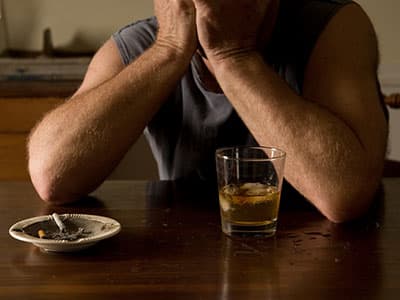PTSD and Addiction
If exposure to a life-threatening event leads to long-term distress, or if your reaction to it becomes chronically and significantly disabling, you might have post-traumatic stress disorder (PTSD). Some people with PTSD may use drugs and alcohol to manage their symptoms and go on to develop addiction.
Ideally, people with PTSD and addiction should have both issues treated at the same time. Treatment may consist of both therapy and medication. Research continues to uncover more about these two conditions and the most effective forms of treatment.
What Is PTSD?
 PTSD is a mental health disorder that develops after exposure to a traumatic event. The traumatic event may be experienced directly, witnessed, or happen to someone close to you.1 Some examples of traumatic events are:2
PTSD is a mental health disorder that develops after exposure to a traumatic event. The traumatic event may be experienced directly, witnessed, or happen to someone close to you.1 Some examples of traumatic events are:2
- Serious accidents.
- Military combat.
- Natural disasters.
- Personal assaults.
- Abuse.
Not everyone who experiences a traumatic event will develop PTSD, and a variety of factors may influence whether someone develops it. For example, women are more likely to have PTSD than men.3
Overall, 3.5% of U.S. adults have PTSD.1,2 However, this rate is higher among military veterans and those whose occupations increase the risk of exposure to traumatic events, such as firefighters, emergency medical personnel, and police.1
Symptoms
After a traumatic event, a number of symptoms must surface for the person to meet the criteria for a diagnosis of PTSD:1
- Intrusion symptoms. At least 1 intrusion symptom must be present.
- Recurrent, involuntary, and troubling memories of the event
- Frequent distressing dreams about the event
- Reactions, such as flashbacks, where one feels or acts like the event is happening again
- Intense or long-lasting psychological distress after being exposed to things that remind them of what happened
- Physical reactions to reminders of the event, such as racing heart
- Avoidance symptoms. At least 1 avoidance symptom must be present.
- Avoiding memories, thoughts, or feelings related to the event
- Avoiding reminders, such as people, places, activities, discussions, objects, or situations that cause memories, thoughts, or feelings related to the event
- Cognitions and mood symptoms. At least 2 negative changes in cognitions and mood must be present.
- Lack of ability to recall key parts of the trauma
- Persistent and inaccurate negative beliefs about oneself, others, or the world
- Persistent, flawed beliefs about the cause or consequences of the event, which typically leads a person to blame themselves or others
- Consistently negative emotional state
- Noticeably reduced interest or participation in activities
- Feelings of detachment from others
- Enduring inability to experience positive emotions
- Arousal and reactivity symptoms. At least 2 noticeable changes must be present.
- Irritability and anger
- Reckless or self-destructive behavior
- Hypervigilance
- Being startled easily
- Struggling with concentration
- Trouble sleeping
Some combination of the above symptoms must be present for at least 1 month for the person to meet the criteria for PTSD. Also, the symptoms must affect important areas of functioning, such as school, work, the ability to maintain relationships with others, or the ability to take care of oneself. Lastly, the symptoms must not be due to other factors, such as another medical condition or substance use.1
Why Do People With PTSD Use Drugs?
Those who struggle with PTSD may feel frustrated and hopeless. Unfortunately, many turn to unhealthy coping mechanisms such as drinking and using other substances. Research shows that almost half (46.4%) of those with PTSD also meet criteria for a substance use disorder. In the vast majority of cases, the development of PTSD precedes the development of an addiction.4
If a person has a substance use disorder, they might: 1
- Have a hard time controlling intake of the substance.
- Need to use more of the substance to obtain the same effects they previously experienced.
- Go through withdrawal symptoms when use stops.
- Continue to use despite negative consequences, such as job loss, difficulty maintaining relationships, legal problems, and financial problems.
Using substances to alleviate symptoms of PTSD is called self-medicating. People who self-medicate may believe that they are reducing their PTSD symptoms. But they are likely creating more issues. For example, some of the symptoms of drug withdrawal may be similar to symptoms of PTSD, including sleep disturbances, difficulty concentrating, feelings of detachment, and irritability. The person may use again to alleviate these symptoms and begin a reinforcing cycle that can lead to addiction.4
 Another possible explanation for why people with PTSD become addicted to drugs and alcohol is the high-risk hypothesis. This theory suggests that the lifestyle of those who use substances typically involves spending time in dangerous environments or participating in high-risk behaviors associated with obtaining or using substances. This may increase the likelihood that they will experience a traumatic event and eventually develop PTSD.4
Another possible explanation for why people with PTSD become addicted to drugs and alcohol is the high-risk hypothesis. This theory suggests that the lifestyle of those who use substances typically involves spending time in dangerous environments or participating in high-risk behaviors associated with obtaining or using substances. This may increase the likelihood that they will experience a traumatic event and eventually develop PTSD.4
Other factors that may influence the development of concurrent PTSD and substance use disorders are genetics, shared abnormalities in certain areas of the brain, and prior exposure to traumatic stressors. Further, military veterans are at an increased risk for both PTSD and substance use disorders, with more severe combat exposure linked to an even higher risk of developing long-lasting PTSD symptoms.4
Those who have both PTSD and a substance use disorder typically experience more issues than those who have one disorder or the other. For example, those with both disorders tend to have increased chronic physical health issues, poorer social functioning, higher rates of suicide attempts and other mental health concerns, more legal problems, more financial problems, an increased risk of violence, poorer treatment outcomes, and less improvement during treatment.4,5
PTSD and Substance Abuse Treatment
In the past, it was common to treat comorbid PTSD and substance use disorder separately. In fact, the substance use disorder was often treated first, and the treatment of PTSD would be put off until the person was sober for a period of time.4
Recently, treatment courses have changed. The integrated model of treatment is used to address both the substance use disorder and PTSD at the same time. The person may see the same clinician for both treatments, rather than seeing 2 separate professionals.4 This approach helps address the complexity of comorbid symptoms, since some may overlap. Further, the person can address triggers and emotions linked with their substance use, which can help foster and maintain recovery.
Medications
Research has found that sertraline, which has been approved for the treatment of PTSD, may additionally help reduce alcohol use in people with earlier onset of PTSD. Disulfiram and naltrexone have also been found to help with abstinence. Desipramine, an antidepressant sometimes used to manage neuropathic pain, may improve alcohol use outcomes as well.4
Currently, the most researched medications for PTSD are antidepressants, which may help reduce symptoms. Research has also shown that prazosin may help with sleep issues, especially nightmares.3
Therapies
For maximum effectiveness, prescribed medications are often combined with other treatment approaches, such as individual or family therapy.
Some of the types of therapy that have been used to treat both PTSD and substance use disorders are:

- Cognitive behavioral therapy (CBT)
- CBT can encourage one to look at how their thoughts, emotions, and behaviors influence one another. CBT allows a person to recognize the triggers that lead to substance use. The person also learns how to cope with the triggers and related symptoms using healthy coping skills. CBT may include more specific types of therapies, including exposure therapy and cognitive restructuring.3
- Exposure therapy is when the person is gradually exposed to their trauma in a safe environment, so that they can learn to cope.3
- Cognitive restructuring may help those with PTSD understand their traumatic memories after they realistically examine them.3
- Prolonged exposure therapy
- At the beginning of prolonged exposure therapy, the therapist reviews the criteria for a PTSD diagnosis and gives the client information to better understand PTSD and its treatment. The therapist then teaches the client relaxation skills, including breathing exercises, that will help them regulate distress after sessions that include exposure. Then, the exposure sessions begin with in vivo exposure.6
- In vivo exposure involves the therapist and client first developing a list of situations that the client fears or avoids, yet are safe to engage in. The client then practices engaging in such situations until their anxiety decreases.6
- Lastly, imaginal exposure takes place. The client repeatedly tells their most upsetting trauma to the therapist for approximately 45 to 60 minutes. These sessions are recorded, and the client listens to them daily. PET usually occurs for 9 to 12 sessions, with each session lasting 60 to 90 minutes. PET has been shown to be an effective, long-lasting treatment for PTSD.6
- Seeking Safety
- The Seeking Safety treatment approach consists of approximately 25 sessions lasting 60 to 90 minutes each. During these sessions, the client and therapist cover a wide variety of topics, such as how to decrease risky behaviors, set healthy boundaries, and cope with triggers that lead to substance use. The main goal of Seeking Safety therapy is to establish a sense of safety.6
- Concurrent Treatment of PTSD and Substance Use Disorders Using Prolonged Exposure (COPE)
- COPE combines CBT for substance use disorder treatment with key aspects of prolonged exposure, such as in vivo and imaginal exposure techniques, for PTSD. COPE helps clients understand the connection between PTSD and substance use and decrease PTSD symptoms. Additionally, COPE helps clients identify and manage cravings, deal with thoughts about using, and identify and plan for risky situations where relapse potential is increased.4
Treatments
There are several different program types and recovery settings for people seeking help for PTSD and substance abuse, including:
- Inpatient treatment. Inpatient programs take place at a residential facility. Individual therapy, family therapy, group therapy, medical care, and psychoeducation may all be included in this type of treatment program.
- Outpatient treatment. Outpatient programs may take place at a clinic or other office. A client might meet once a week or several times a week, but sessions are typically led by a professional who specializes in substance abuse counseling. Clients may share about their struggles with substance use with the group and may also need to complete homework assignments that foster self-reflection and learning about substance use, related risks and concerns, and triggers. They might also be encouraged to engage in individual therapy and/or family therapy.
- 12-step programs. Twelve-step programs, such as Alcoholics Anonymous or Narcotics Anonymous, also take place in a group setting. During these groups, clients hear others share their experiences with substance use and sobriety. They may also find support through the help of a sponsor.
- Support groups. Support groups may or may not be led by a professional and can be on a variety of topics including substance use, PTSD, or both.
- Veterans programs. Programs for veterans are available through the Veterans Administration (VA). Programs may focus on substance use, PTSD, or both. Again, the client might be encouraged to engage in other types of treatment as well, including individual therapy, family therapy, or psychiatric medication.
There are such a variety of treatment options for comorbid PTSD and substance use disorders that it can be overwhelming. Find the treatment option that you feel most comfortable with and that fits you best so that you can get the help that you need and deserve. If you or someone you know struggles with PTSD, a substance use disorder, or both, get help today.
Sources
- American Psychiatric Association. (2013). Diagnostic and Statistical Manual of Mental Disorders: Fifth Edition. Arlington, VA: American Psychiatric Association Publishing.
- National Institute of Mental Health. (N.D.) Post-Traumatic Stress Disorder Among Adults.
- National Institute of Mental Health. (2016). Post-Traumatic Stress Disorder.
- McCauley, J. L., Killeen, T., Gros, D. F., Brady, K. T., & Back, S. E. (2012). Posttraumatic Stress Disorder and Co-Occurring Substance Use Disorders: Advances in Assessment and Treatment. Clinical Psychology: A Publication of the Division of Clinical Psychology of the American Psychological Association, 19(3),
- U.S. Department of Veterans Affairs. (2017). Treatment of Co-Occurring PTSD and Substance Use Disorder in VA.
- Berenz, E. C., & Coffey, S. F. (2012). Treatment of Co-occurring Posttraumatic Stress Disorder and Substance Use Disorders. Current Psychiatry Reports, 14(5), 469-477.

